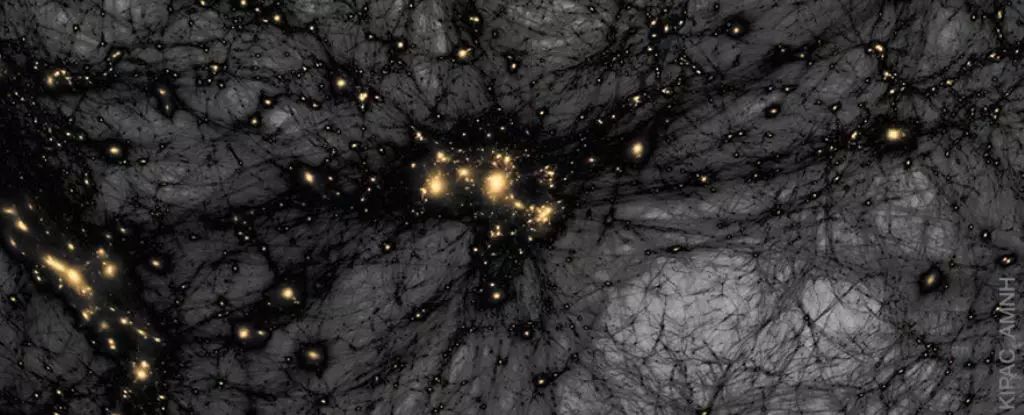In the realm of modern cosmology, the standard model has stood firm, laying the groundwork for our understanding of an expanding universe. However, a significant enigma lurks at its core—the Hubble tension. This discrepancy between the observed rates of cosmic expansion during the early universe and their more localized measurements in recent times is prompting scholars to reassess long-held beliefs. While the consensus suggests that our universe is in perpetual motion, the divergence between observations raises crucial questions about the fundamental nature of the cosmos. With various hypotheses ranging from flaws in general relativity to the possible absence of dark matter, the landscape is ripe for new ideas that challenge the existing paradigms.
Beyond Conventional Wisdom: The Case for Evolving Dark Matter
Among the many theories proposed to address the Hubble tension, one stands out for its audacity—the notion of evolving dark matter. While dark energy has been a subject of much debate, the concept of evolving dark matter has not garnered the same level of attention. This oversight may stem from the robust observational evidence supporting the existence of non-luminous material that interacts weakly with light. Yet, the palpable absence of direct observations of dark matter particles leaves gaps in our understanding, making the quest for alternative explanations all the more pertinent.
Interestingly, the discussions surrounding dark matter often veer towards dismissing its existence altogether, with many scholars favoring modified gravity theories. However, what if the answer lies not in the dismissal of dark matter but in its re-evaluation? Recent intrigues into the possibility of an exotic form of dark matter, one that possesses a malleable equation of state, could present a more harmonious alignment with the currently available observational data.
Theoretical Underpinnings: Linking Dark Matter and Dark Energy
The intricate relationship between evolving dark matter and dark energy deserves more exploration, as emerging theories propose that these two entities could be intertwined. By examining how the evolution of the universe hinges on energy density and matter density ratios, it becomes apparent that a steady dark matter model, when juxtaposed with evolving dark energy, starts to parallel scenarios where dark matter itself undergoes transformation. This exciting interplay invites cosmologists to contemplate the nuances of dark matter’s role in shaping our universe’s trajectory.
Crucially, the idea of an oscillating dark matter equation of state is not purely speculative. Drawing parallels between cold dark matter and neutrinos—particles that exhibit mass variations—helps reinforce this perspective. Neutrinos, despite their elusive nature, showcase an intriguing trait: mass oscillation. Could analogous behaviors exist in cold dark matter? This journey into speculative physics opens new avenues for conceptualizing dark matter, potentially enriching our comprehension of the cosmos.
Implications of Oscillating Dark Matter Models
Recent findings suggest that a universe comprising approximately 15% oscillatory cold dark matter, alongside the traditional 85%, may be ideal for reconciling the Hubble tension while adhering to prevailing dark matter observations. Such a model offers a refreshing perspective on the compatibility of dark matter with observational data, potentially ushering in a paradigm shift within cosmology.
However, while these theoretical propositions are invigorating, it is essential to recognize their preliminary status. The authors advocating this concept label it a “toy model,” indicating that while the ideas exhilarate, they do not provide definitive answers or specifications concerning dark matter particles. Even so, this fascinating model lays groundwork for further exploration and encourages researchers to broaden their horizons regarding dark matter.
A Call for Exploration: Rethinking Cosmological Foundations
The notion of evolving dark matter challenges entrenched beliefs and invites cosmologists to reconsider what we think we know about the universe. This burgeoning theory not only has the potential to resolve longstanding discrepancies—such as the Hubble tension—but might also catalyze a foundational shift in our understanding of cosmic evolution. Given the complexity of the universe, such radical inquiries are not only warranted but essential for driving the field forward.
As the cosmos continues to captivate our imagination, the evolving narrative surrounding dark matter calls for a more nuanced investigation. In the face of persistent uncertainties, embracing innovative approaches may ultimately illuminate the mysteries woven into the fabric of our universe, paving the way for groundbreaking discoveries that redefine our place within it.


Leave a Reply